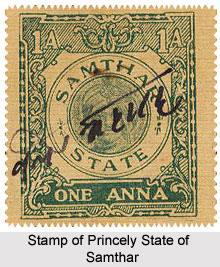 The Princely State of Samthar was one of the prominent princely states of India that were administered by native rulers or Indian princes under the indirect control of the British Government of India. The state covered a total area of 178 sq miles and comprised of a total population of 38,279 in the year 1941. The state of Samthar included around 91 villages and 1 town in the year 1941. The territory was bordered by the British United Provinces of Agra and Oudh on all sides, and the Gird Gwalior district of Gwalior in the western region. Samthar state consisted of three separate blocks of territory. The word samthar means alluvial plain, from which the name of the state has been derived. It was incorporated as a part of the Bundelkhand Agency, under the Central India Agency.
The Princely State of Samthar was one of the prominent princely states of India that were administered by native rulers or Indian princes under the indirect control of the British Government of India. The state covered a total area of 178 sq miles and comprised of a total population of 38,279 in the year 1941. The state of Samthar included around 91 villages and 1 town in the year 1941. The territory was bordered by the British United Provinces of Agra and Oudh on all sides, and the Gird Gwalior district of Gwalior in the western region. Samthar state consisted of three separate blocks of territory. The word samthar means alluvial plain, from which the name of the state has been derived. It was incorporated as a part of the Bundelkhand Agency, under the Central India Agency.
History of Princely State of Samthar
The Bargujar Rajputs were the ruling family of the state. Maharaja Indrajit depended on the support of various petty chiefs, including Naune Shah Gujar, to overcome other contenders for the royal throne or gadi. After Indrajit ascended the throne, he rewarded the sone of Naune Shah, named Madan Singh with the fort of Samthar and a jagir of 5 villages. Later it was bestowed upon Devi Singh, the son of Madan Singh. During the disorder caused by the invasions Maratha Empire, Ranjit Singh, son of Devi Singh, became independent and was granted the title of Raja from the Maratha rulers. Later the native ruler was afforded protection by the British government and his lands appointed as a state in a treaty that concluded in the year 1817. The last ruler of the princely state of Samthar was the 12th of his line.
The Princely State of Samthar was honoured as one of the salaute states of India with a gun salute of 11 guns. The native ruler of the state held the title of Raja and was invested with the powers of a ruling chief. He took charge of the administration of the princely state and was supported by the Diwan. Samthar was one of only three states in Bundelkhand to have treaties with the British government of India. The other 2 states were Datia and Orchha. Other states were under the control of their chiefs under ikrarnamahs. As the Raja supported the British forces during the great revolt of 1857, in the year 1862 the British Government of India eradicated the obligation of Samthar state to pay annual relief or nazarana to its overlord on each succession. The native currencies of Datia rupee and Jhansi Nanashahi rupee were replaced in the princely state of Samthar by the British currency.
At present, Samthar is a municipal board and a city in the district of Jhansi in the state of Uttar Pradesh.



















